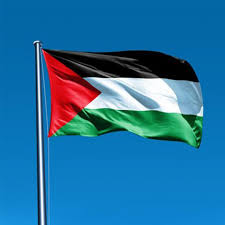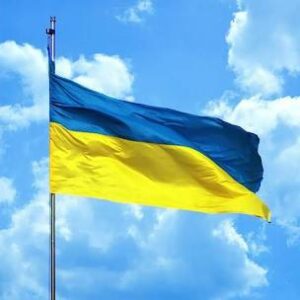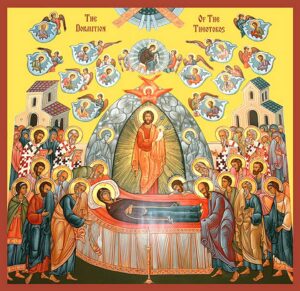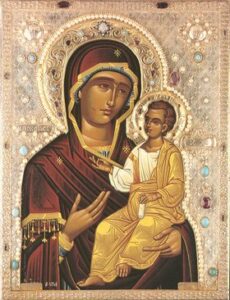

Please pray for the suffering people of Ukraine and the Palestinian people of Gaza and the West Bank.
____________
The Dormition of the Theotokos

August 15
“What’s happened to Mary?” “I don’t know… We hadn’t thought about it.”
That was the general Protestant approach – my approach – when I was young, even in the Methodist and Episcopalian seminaries I attended. * (Maybe that’s all changed in the sixty-five years since I left. I don’t know.) The subject of the Virgin Mary was “tabu”, off limits – a leftover from the Protestant Reformation, the rejection of what they deemed excessive Roman Catholic devotion to her and the general idea that she played any role in the salvation of mankind.
- I should mention that a feast of “The Blessed Virgin Mary” now appears in most revised Anglican Prayer Books, but except in a few “high church” parishes, not much attention is paid to it. At my former home parish, which once celebrated the feast with some splendor, there is not even a celebration of the Holy Eucharist scheduled for the day.
One of my Anglican professors said that if you loved your mother, which you would rather: that someone over-praise her a bit, or that the person give her a kick in the shins?
Did the Virgin Mary play a role in the salvation of mankind? Yes, of course she did. It was through her and her “Let it be to me according to your word” that Christ became incarnate, that He took on a human Body and the salvation of human race was made possible. That is why Orthodox recite the Creed in its original form, giving her equal credit: Christ “was Incarnate of the Holy Spirit and the Virgin Mary”. Not the Western Christian version: “and was incarnate by the Holy Spirit of the Virgin Mary”, as if she played only a passive role in the process. Not to mention that she raised Him, shaped Him, knew Him, loved Him as only a mother can.
By Baptism, we have been incorporated into the Body of Christ – which means that Christ’s divine Father becomes “our Father”, and Christ’s human Mother becomes our Mother. If this isn’t Biblical I don’t know what is. Besides, next only to her Son Himself, Mary is the human being most mentioned in the New Testament.
“Bible-alone” Christians firmly believe in the Virgin Birth. Don’t they ever wonder what became of the Virgin Mary? I mean, I know my mother’s soul has moved on, and I pray for her morning and night and sometimes in between. But I also know and care where my mother’s body is buried: in a cemetery outside the little Ohio village where I grew up. When my health still permitted it – and maybe someday again? – I’d go back and say the Trisagion Prayers there for her and for my dad. Maybe this sounds silly, but one time I took a sandwich there and had lunch with them. It has been important to me to know where my mother’s body is buried.
So, to repeat, why don’t “Bible alone” Christians care about where Mother Mary is now? It’s on principle: because, in light of their “Bible alone” theory, they say the Bible doesn’t tell us. * Which is false.
- The Bible doesn’t say anything about Luther and Calvin either, but let’s not go there now.
Turn to the Revelation of John, chapter 12, concerning the woman “in heaven: a woman clothed with the sun, with the moon under her feet, and on her head a garland of twelve stars…” who gave birth to “a male Child who was to rule all nations with a rod of iron”, whose “Child was caught up to God and His throne.”
Granted, Revelation contains much symbolism, some indecipherable to us who are not First Century Christians. But this one is clear. There can be only one “male Child” Who fits the criteria here: Jesus Christ, the Son of Mary. Some say the woman is the Church who in the Holy Eucharist brings Christ into the world – or even Judaism who “gave birth” to Christ, so to speak. Yes. Often in the Scriptures we find symbols with double or even triple meanings, some doubling back on one another.
But can you imagine John writing this without the Theotokos being first in his mind, the woman who literally gave birth to Jesus Christ? Mary who had become his own Mother, left in his care by his Lord Jesus Christ from the Cross? Mary who lived with him in Ephesus for many years. Surely this holy woman was always at the front of his mind.
And he sees her now, shining not with her own light, but “clothed with the Sun”. Read chapter one: the appearance of Jesus Christ, “His countenance like the sun shining in full strength”. She shines with His Light. She stands “with the moon under her feet, and on her head a garland of twelve stars”. Now taken above the world, adorned with the twelve Apostles/the Church, perhaps also with the twelve tribes of Israel. That is the Virgin Mary, now glorified in Heaven.
The Bodies of the Saints
Let’s approach it like this.
People always treasure the bodies and grave sites of our heroes. Khouria Dianna and I have visited George Washington’s grave at Mount Vernon, and Abraham Lincoln’s tomb in Springfield, Illinois, and Thomas Jefferson’s at Monticello.
From the beginning Christians have also quite naturally treasured the bodies of our heroes and heroines.
The body of Saint Peter the Apostle lies in Saint Peter’s Basilica in Rome.
The chief relics of Saint James the Apostle lie in the Cathedral of Santiago de Compostela in northwest Spain, taken there for safekeeping after his martyrdom.
The chief relics of Saint Matthew the Apostle are located in the crypt of Salerno Cathedral in Italy.
And so on.
Not only were the bodies of saints reverenced. Also “relics”, portions of bones of the saints, have often been distributed among many churches. As a convert to Orthodoxy, this seemed to me at first to be a rather revolting morbid practice. But I’ve come to understand: For one thing, miracles sometimes happen through these relics. But perhaps more important, it was so the faithful could gain a sense of their reality. Our Faith is not grounded in myths: These were real people who really lived. Our Faith has substance. Saint Nicholas’ body lying in his crypt at San Nicola Basilica in Bari, Italy, and our small relic of Saint Nicholas here at Saint Nicholas Church, Cedarburg, demonstrate that, no matter what skeptics might say, Saint Nicholas was a real living person.
So here’s the point:
Q. Where is the body of the Virgin Mary? Where are her relics?
A. There aren’t any.
Furthermore, no one from ancient times till now has ever claimed to have any. This, I think, is the chief evidence that she has been taken to Heaven in her whole being, both soul and body. Roman Catholics title this the “Assumption” of the Virgin Mary. Orthodox hymns refer a bit more cautiously to the “translation” (reverent moving) of the Theotokos.
Courtesy of Canarino3075
The Dormition * of the Theotokos
- in Greek: Kimisis (Κοίμησις)
This is the only official Orthodox title for the Feast of Mary’s departure. It means “falling asleep”, a term Saint Paul used for “dying”. (See 1 Thessalonians 4:13-18.) It means that for faithful Christians death is like falling asleep on “this side” with Christ and waking up on “the other side” still with Christ.
Oddly, the Greek word is usually translated into English using the Latin term: “Dormition”.

Orthodox icons show the body of Our Lady laid out for burial, the Apostles gathered around, and her Son gently receiving her soul in the form of a small child – taking it, taking her away for her “birth” in the Heavens. Our iconography goes no further. It does not suggest (one way or the other) whether He also received her blessed body.
Tradition from early times says the Mother of God died and was buried in Jerusalem, in the Kidron Valley at the foot of the Mount of Olives. An early story (legend?) says that on the third day after her burial, Thomas arrived late as usual and wanted to venerate her body, so they opened the tomb, and it was empty. We can visit there today. * It’s still empty.
- By the way, most sources, even Trip-Advisor, advise against going there right now, for obvious reasons.
In giving birth, you preserved your virginity. In falling asleep you did not forsake the world, O Theotokos. You were translated to life, O Mother of Life, and by your prayers, you deliver our souls from death.
The Assumption of the Blessed Virgin Mary
It was not till November 1, 1950, that this became a dogma (required belief) for Roman Catholics, promulgated by Pope Pius XII who, after consulting with and researching other authorities, proclaimed that “by our own authority, we pronounce, declare, and define it to be a divinely revealed dogma: that the Immaculate Mother of God, the ever Virgin Mary, having completed the course of her earthly life, was assumed body and soul into heavenly glory…. It is forbidden to any man to change this, our declaration, pronouncement, and definition or, by rash attempt, to oppose and counter it. If any man should presume to make such an attempt, let him know that he will incur the wrath of Almighty God and of the Blessed Apostles Peter and Paul. … Hence if anyone, which God forbid, should dare willfully to deny or to call into doubt that which we have defined, let him know that he has fallen away completely from the divine and Catholic Faith.”
We Orthodox would apply that judgment only to someone who denied the Creed.
Orthodox Teaching about what’s happened to Mary
Some years ago an Anglican professor friend of mine was considering Orthodoxy. For reasons I can’t recall, he said his “test question” for us was this: What do Orthodox believe about the Assumption? Was she taken bodily into Heaven or was she not? Yes or No?
I pondered for a while and finally answered: “Well… … …” and then the standard Orthodox answer: “It’s a Mystery”. And then I explained.
On one hand, if he meant: Do we have a Dogma requiring belief that the Theotokos was taken bodily into Heaven? then No. We do not. Orthodoxy is formally committed only to the ancient Tradition of the Church: the Holy Scriptures, the universal teachings of the Holy Fathers, the dogmatic decisions of the Ecumenical Councils. We have no modern dogmas – and are perplexed why the Roman Catholics finally required belief in Mary’s Assumption in 1950.
And, I think, again No. Orthodox doctrine is generally carried by our liturgical texts. Thus far * I’ve spotted no clear reference to the Theotokos being taken bodily into the Heavenly Places.
- I’ve prayed or read a good many of the Orthodox Church’s hymns for the Dormition, though certainly nowhere near all of them. (You non-Orthodox cannot begin to imagine the vast extent of our hymnology.)
However, on the other hand: Yes. Belief that the Theotokos was taken bodily into Heaven seems to be assumed by most major Orthodox theologians, from Saint John of Damascus in the Eighth Century (based on earlier sources) to Vladimir Lossky in the Twentieth.
And, if we can find yet another hand: Yes. Without causing the least controversy, Orthodox churches are dedicated to Mary using the common Roman Catholic title! Note: Assumption Greek Orthodox Church in Madison, Wisconsin, and Assumption Greek Orthodox Church in Chicago, Illinois.
One more Yes. I would guess most Orthodox believe it.
Do I believe the Theotokos was taken soul and body to Heaven? Yes, I do – based on the circumstantial evidence.
How did my Anglican friend react to this? Negatively. He wanted a neat definitive dogmatic answer, Western Christian style. None of this “It’s a mystery” business for him.
Mary in the Church
I think this is relevant to the subject at hand – evidence that something unique has happened to Christ’s Mother.
Where is Mother Mary? We have been talking about her body which is not here.
However, she is here – everywhere in the Church.
Some years ago, Father Alexander Schmemann wrote a little book titled The Presence of Mary, * in which he argued, in essence, that if you just hang around the Church for a while, you’ll know for yourself she is here. Other saints show up occasionally for this purpose or that. But she, with her quiet gentle healing presence, seems to just be… here. So many Orthodox “know” this. And her healing miracles are beyond enumeration, as are her weeping icons.
- now out of print, I think
One Sunday many years ago a very fussy, often cranky bishop was visiting our Saint Nicholas, Cedarburg. * Deacon John (+ of blessed memory) and I were nervous wrecks. We were beginning the Proskimidi service before Divine Liturgy. As we said the prayer before the icon of the Theotokos, I could feel a calmness, a coolness flowing forth from her. I was startled, but after that I was almost at ease. I did not tell this to anyone. After the Liturgy, Deacon John said to me: “You know, as we were standing before the icon of Mary, I felt a calmness coming from her, and after that I wasn’t so nervous any more.”
- He is long retired. Let me state clearly that all other bishops I’ve known in our Antiochian Archdiocese have been the soul of charity and kindness.
Two nights ago at Saint Nicholas we sang the last Paraklisis hymn of the Pre-Dormition season – actually well over fifty short hymns to the Virgin. There is a similar “Akathist” to the Mother of God with even more hymns to her, sung on successive Lenten Fridays. Almost every Orthodox Litany ends with an ascription to the Theotokos and then to Christ in the Trinity. Likewise towards the beginning of Divine Liturgy: “Through the prayers of the Theotokos”… three times.
I became Orthodox because I believe in Orthodoxy’s commitment to the Apostolic Faith, but all this “Mary” business seemed excessive to me. Why was it here? I couldn’t figure it out.
Courtesy of ‘That They All May Be One” site.
Then I realized: It came from Orthodox Christians’ experience with “The Presence of Mary” – from our ever-increasing awareness that the Blessed Mother of God is present with her Son in His Church. Just hang around for a while, and you’ll know it for yourself.
Protestants often accuse Orthodox and Roman Catholics of making Mary into an idol, a mother goddess. They’ve got it backwards. God made Mary into a mother goddess.
There’s nothing idolatrous about that. All of us, if we will have it, are destined to become gods and goddesses. Saint John: “We shall be like Him.” Saint Athanasios: “God became man, so that man might become God.” The Holy Theotokos is just the first of us to get there.
But don’t misunderstand. She never stands alone. Almost all genuine Orthodox icons show her presenting her Son to us, leading us to Him.

I feel sorry for Christians who don’t know Mary for themselves, don’t feel close to her. What a shame to know Father and your Brother and the other brothers and sisters, but not know Mom. That was me, once upon a time.
Oh yes, regarding my Anglican professor friend earlier in this Post. On his deathbed he was chrismated and received his first (and last) Holy Communion as a member of the Holy Orthodox Church.
Nest Week: from Frederica Mathewes-Greene: a good article on Men in the Orthodox Church
Week after Next: You’ll just have to wait and see…
My godfather gave me a meditation on as we stood looking at her icon, “The Creator of all Creation lays within Her”. Perfection Personified!